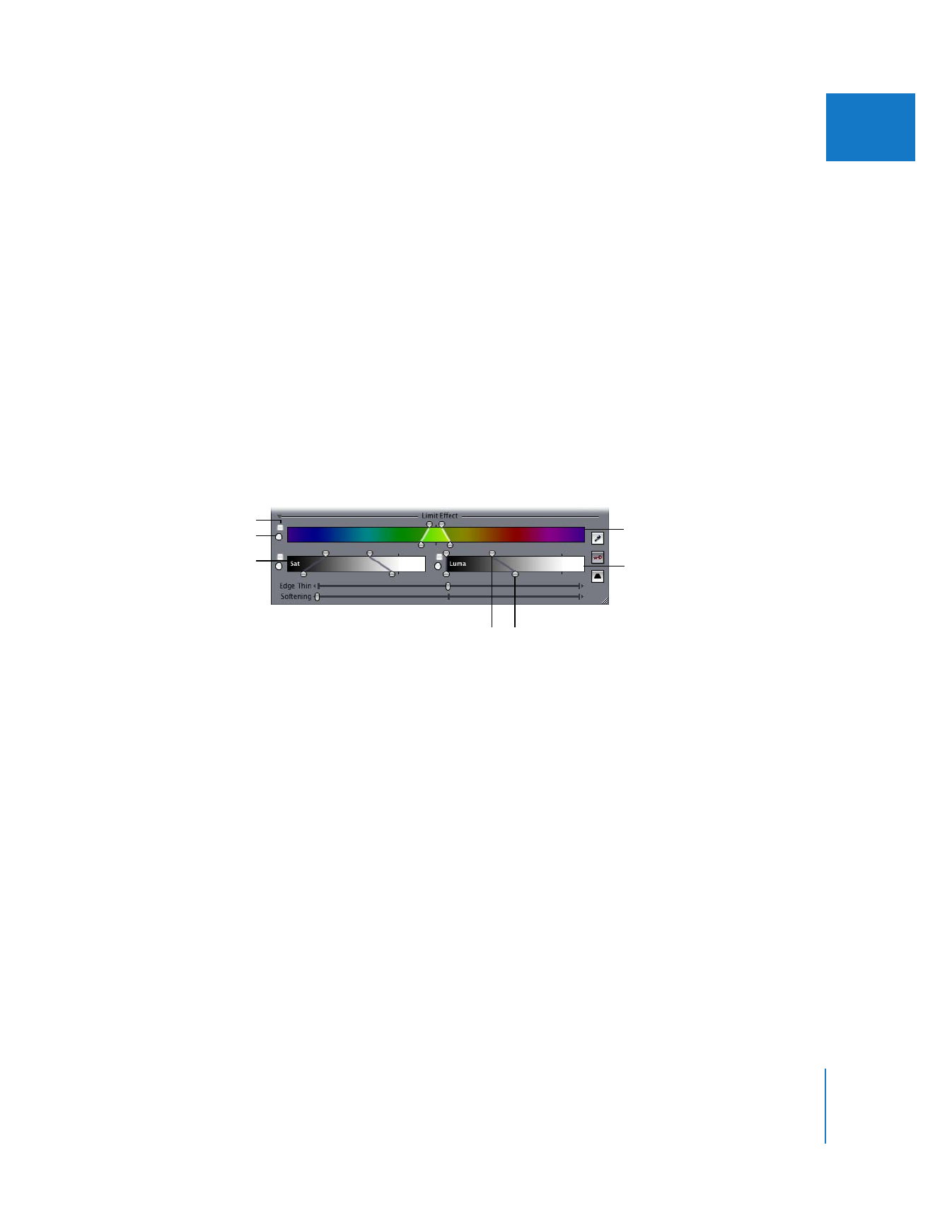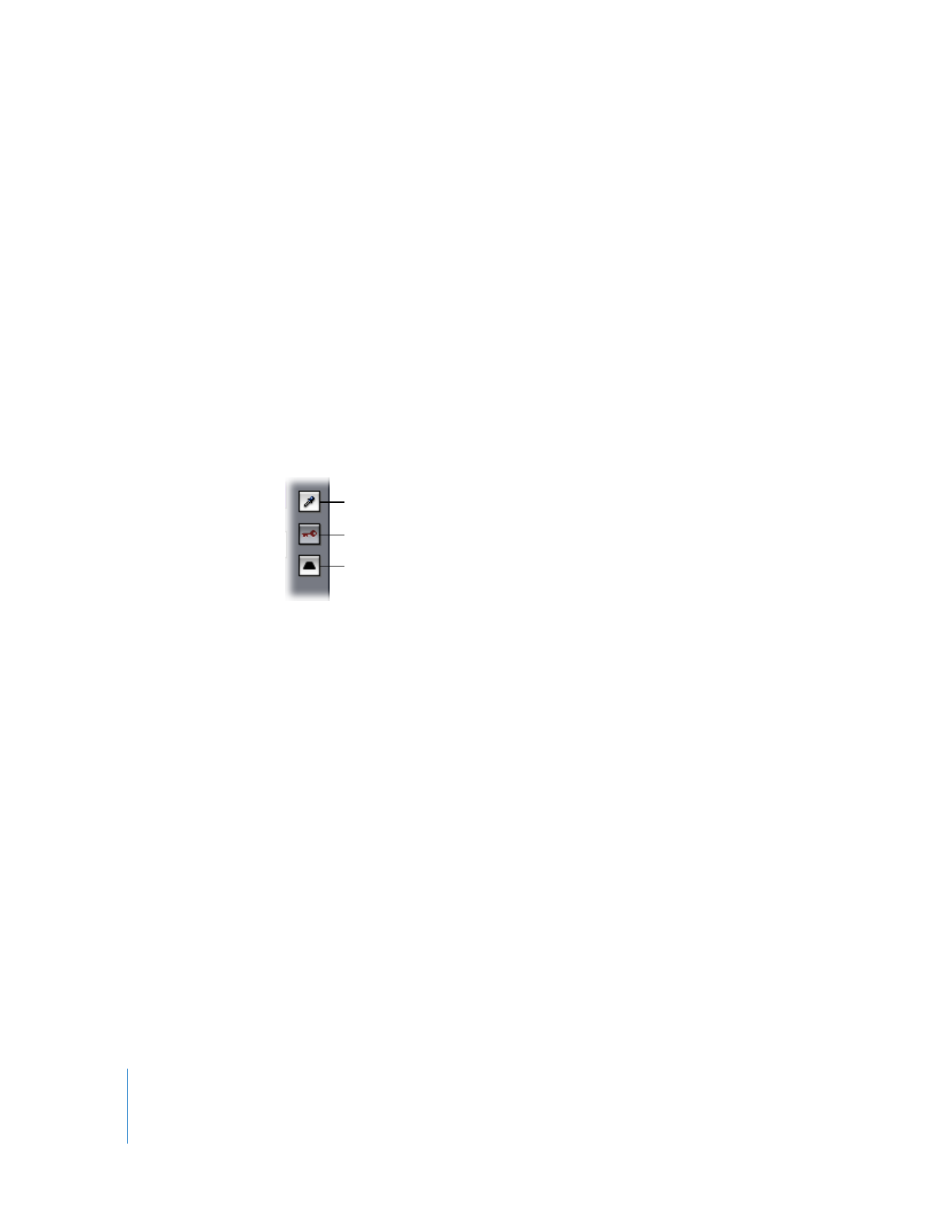
Limit Effect Controls
You can use the color value, saturation, and luma of your clip together or separately to
perform a key using the Limit Effect controls. For example, if you want to modify only
the bright areas of your picture, you can disable both color and saturation and then
perform only a luma key.
 Enable/Disable checkbox: Make sure there’s a checkmark in this checkbox for the
Limit Effect controls you want to use. This lets you add or remove color, saturation, or
luma from the criteria used to define a key.
 Reset button: Click to restore the Color Range, Saturation, and Luma controls to their
default values. Shift-click the button to reset all three controls at once.
 Color Range control: Allows you to fine-tune the range of color that you want to key on.
 Top handles: Let you select a larger or smaller range of colors that are keyed, based
on the original colors you selected with the Select Color eyedropper. These
handles correspond to the Chroma Width control in the numeric filter controls.
 Color gradient: Drag left or right within the color gradient to shift the overall hue
of the color range you’ve set with the top set of handles. This corresponds to the
Chroma Center control in the numeric filter controls.
 Bottom handles: Allow you to define the tolerance of your key. These handles
correspond to the Chroma Softness control in the numeric filter controls.
Top handle
Enable/Disable checkbox
Reset button
Saturation control
Luma control
Color Range control
Bottom handle

604
Part III
Color Correction and Video Quality Control
 Saturation (Sat) control: Allows you to adjust the degree and range of saturation that
contributes to defining your key. The top and bottom handles work the same as
those in the Color Range control. Drag left or right within the gradient to move all
four handles simultaneously.
 Luma control: Allows you to adjust the degree and range of luma that contributes
to defining your key. The top and bottom handles work the same as those in the
Color Range control. Drag left or right within the gradient to move all four
handles simultaneously.
 Edge Thin slider: Allows you to modify the keyed area by shrinking or expanding it.
Using Edge Thin, you can control a noisy key, filling in small gaps and adjusting the
edge of the key to include borderline values that are otherwise difficult to get at
using the other controls.
 Softening slider: Allows you to soften the edges of the key, creating gentler
transitions between affected and unaffected parts of the image.
 Select Color eyedropper: When you click this eyedropper, the pointer turns into an
eyedropper you can use to select a color from a clip in the Video tab of the Viewer or
in the Canvas. Shift-clicking this eyedropper allows you to select another region of
the background screen that wasn’t keyed out by your first use of this control, thereby
broadening the range of colors to be keyed out and enlarging the keyed-out area.
You can do this repeatedly to broaden the range of keyed-out color to include
shadows or highlights on the background screen, if necessary.
Invert Selection button
View Final/Matte/Source button
Select Color eyedropper

Chapter 27
Color Correction
605
III
 View Final/Matte/Source button: This button has three states:
 Final: The default state (a gold key against a gray background) allows you to see
the end result—the effect happening within the keyed area.
 Matte: The second state (a black key against a white background) displays the
key itself as a grayscale image, so you can fine-tune it without being distracted
by the image.
 Source: The third state (a gold key against a blue background) shows only the
original video image.
 Invert Selection button: Click this button to invert the key you’ve defined. For
example, if you’ve set up a key based on the color of a green car and turned the
desaturation all the way down so that the car is grayscale and the background is
color, clicking the Invert Selection button makes the background turn grayscale, and
the car appears in color.